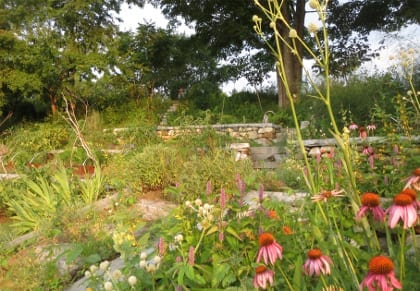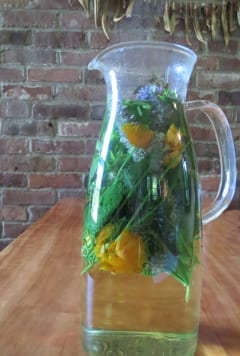by Todd Lynch
In the wellspring of DIY that has made permaculture and edible landscapes household terms, native medicinal plants are outside many conventional conversations about edibles. Although institutions and homeowners rarely consider the value of these plants when weighing their options for a “productive” or self-sustaining landscape, medicinal plants are a valuable landscape resource that can provide multiple benefits to both landscape and land owner.
Perhaps a reason for the absence of medicinal plants in landscape conversations is an often negative characterization of plant-based medicine with a focus on the perceived dangers combined with recent media spotlights on the adulteration of herbal supplements. While these concerns are valid to a degree, with some time invested in education and the right reference materials, folk medicine consisting of teas, honeys, and poultices for non-emergency or chronic conditions can be safe, effective, and less intensive on the landscape than conventional medicine. Growing medicine at home also has the advantage of providing people a known provenance for their herbs fostering a deeper connection to the landscape and giving people a way to access age-old cultural traditions of herbalism.
New Uses for Familiar Plants
Native medicinal plants are already part of our local landscape vernacular. Plants like anise hyssop (agastache foeniculum), New Jersey tea (ceanothus americanus), Purple cone flower (Echinacea sp.), great blue lobelia (lobelia siphilitica), California poppy (eschscholzia) and bee balm (monarda sp.) are wonderful examples of plants that many are familiar with and have outstanding habitat and medicinal/cultural/aesthetic value. I believe that growing these plants and integrating them into our lives as medicine deepens our relationship with these plants and to the ecosystems around us.
While consumption of nursery stock would be inadvisable, there are sources (shared below) for these familiar landscape plants that are organic, certified for human use, and best suited for growing for medicinal use. Tea infusions of these plants are an easy, safe and accessible way for people to experience the benefits of these plants safely and may inspire further education and explorations of herbal medicine. A listing of several plants of interest to herbalists appears below. Keep in mind that a major benefit of using medicinal herbs is that these plants do not contribute to the presence of non-degradable chemical compounds in our waters as pharmaceuticals do (Science Daily April 2013).
Making Sustainable Choices
There is contention within the native plant community about planting seed/root stock from one region into another because of risk of compromising native populations. However, with certain plant species that meet the United Plant Savers criteria for at-risk species, such as American ginseng (panax quinquefolius), I believe the benefits of growing the plants and re-populating human-impacted areas where populations have gone extinct outweigh other considerations.
Typically, native medicinal plants are wild harvested. Landscape designers can help sustain wild populations of medicinal plants, like ginseng and purple coneflower, by integrating those plants into their installations. Cultivation of rare and endangered plants can help to reduce pressure to harvest wild populations, while at the same time helping to ensure the survival of these species. Raising awareness of the threat of extinction in the wild through educating clients also can help wild populations of plants as people realize the many levels of value these plants provide. Organizations like United Plant Savers, as well as local native plant societies and botanic gardens, can be important resources to consult for guidance and education.
A Wealth of Benefits from Medicinal Plants
One of the most compelling motivations to integrate native medicinals into the landscape is the multi-layered benefits that they provide to habitat, ecosystem services, and social and cultural value, as well as wellness for people. One of the best examples of a plant offering multiple benefits is pleurisy root – Aesclepias tuberosa. It has showy flowers with vibrant sprays of orange that bloom midsummer. Aesclepias is one of the primary foods for monarch butterflies, a species that is facing challenges as its habitat is destroyed in Mexico and in the United States. According the Lady Bird Johnson plant database, it also attracts beneficial insects to the garden that feed on pests. The root is used medicinally to treat coughs, winter colds and other respiratory conditions. Aesclepias is also deer resistant, which for many designers is a critical consideration for installations. The plant is well-adapted for wet or dry conditions which can suit the challenges of urban soils.
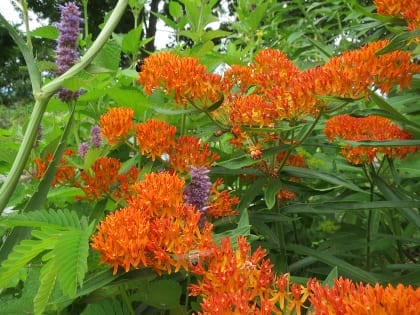
Aesclepias tuberosa is a primary food source for monarch butterflies and its root can also be used medicinally to treat winter colds and upper respiratory conditions.
Another advantage of integrating these native medicinal plants into the landscape is economic. Because many of the native medicinals are perennial and are often drought and deer resistant, fewer inputs of water and fertilizer are required to sustain them and there is a reduced risk of the plants being eaten. Also, many medicinal plants can be made into tinctures which are an efficient way to extract powerful medicine in a small concentrated volume that are highly valued. They also require less space than crops like blueberry bushes or raspberries to generate income. The many levels of wellness, beauty, and ecological benefits – in essence, multi-purpose landscapes combining habitat, social, and cultural value and documented value for physical health – make them an important component to an integrated “productive” landscape.
Enjoying the Rewards
These plants can also give us a renewed connection to the broader landscape and ecology around us and within us. Many people can relate to the sensations of glory and of gratitude felt when slicing a homegrown tomato or eating a fistful of just picked warm blueberries. Those sensations root us to our landscapes and the places around us. We have worked for those fruits, and many levels of hunger are sated when we consume them. I had those same feelings for boneset and California poppy while in the depths of a fierce fever/flu this past February. An instructor of mine pointed out that few have that same sense of gratitude and experience of deep healing from a pill or flu shot that they do for a remedy that they have grown and seen in their landscape. Indeed, boneset and California poppy now receive special attention in my garden, and I am sure to plant them in my clients’ gardens as well. By installing these plants in the landscape and giving clients an understanding of their different possible uses, we empower our clients to engage with the landscape on an active, meaningful, and potentially restorative level.
Design solutions (and health diagnoses) consist of more than simply fixing a symptom or problem and focusing on one approach to wellness. As ecological design professionals who work with landscapes that need restoration, we understand the need for a multi-dimensional approach to achieve resilience. To restore a landscape, all systems must be addressed and nurtured to health with time and a multi-faceted approach. The same holds true with our own personal health. Including native medicinals in installations works to restore large-scale landscape habitat and ecology as well as the ecology of individuals – clearly illustrating a fundamental connection people share with the landscapes they belong to. Edible landscapes can nourish and support all systems of the body, the spirit, and the broader landscape. Native medicinal plants as part of the edible landscape can help broaden the dimensions of our approach to an integrated landscape and bring us closer to achieving a truly local health and wellness system from the landscape scale to the personal scale.
Useful Plants for Novice Herbalists
For specific tea-making instructions, refer to resources like Rosemary Gladstar’s books (refer to Educational Resources below). Also note that these plants are meant to support overall health; serious medical emergencies or chronic ailments require treatment from a trained professional.
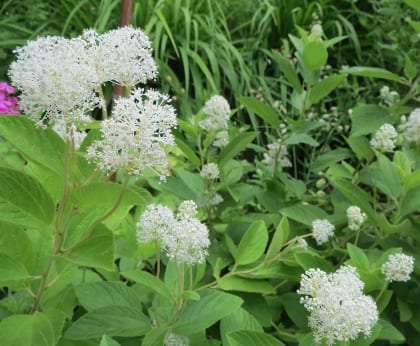
Ceanothus americanus
New Jersey Tea
Parts used: leaves, twigs
Tea of leaves and twigs is a non-caffeinated drink to substitute for black tea to relieve stress.
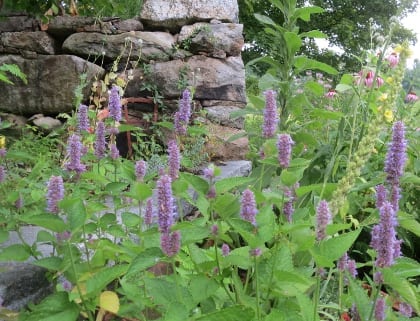
Agastache foeniculum
Anise Hyssop
Parts used – leaves, stems, flowers
Tea of fresh or dried leaves, stems, and flowers aids digestion, helps lower fevers, and is great as iced tea in the summer
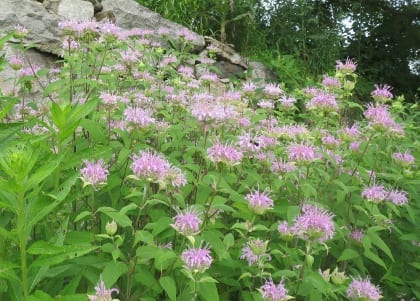
Monarda didyma
Bee Balm, Oswego Tea
Parts used: flowers and leaves
Tea of flowers and leaves helps treat winter illnesses, respiratory conditions, and digestion complaints
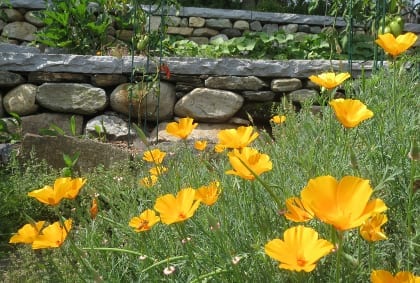
Eschscholzia californica
California Poppy
Parts used: flowers, leaves, and roots
Tea made from all parts of the plant is used to relieve anxiety and stress as well as to relieve pain
Educational Resources
United Plant Savers www.unitedplantsavers.org – a non-profit organization devoted to the protection of native medicinal plants and their habitats.
Growing 101 herbs that heal, gardening techniques, recipes and remedies, Hartung, Tammi,
Storey Publishing, North Adams, 2000.
Making Plant Medicine, Cech, Richo, Horizon Herbs, Williams, OR, 2000.
Rosemary Gladstar’s Medicinal Herbs: A Beginner’s Guide: 33 Healing Herbs to Know, Grow, and Use, Gladstar, Rosemary, Storey Publishing, North Adams, 2012.
Cary Institute of Ecosystem Studies. “Streams stressed by pharmaceutical pollution.” Science Daily. ScienceDaily, 1 April 2013. www.sciencedaily.com/releases/2013/04/130401090709.htm.
Sources for plants
Horizon Herbs www.horizonherbs.com, Williams, Oregon
Johnny’s Seeds www.johnnyseeds.com , Winslow, Maine
Prairie Moon Nursery, www.prairiemoon.com, Witoka, Minnesota
About the Author
Todd Lynch is the principal of Ecotropy LLC, a landscape design studio serving Western Massachusetts and beyond. Todd integrates medicinal plants, ecology and art to create outdoor spaces that strengthen and illustrate the connections shared by human and ecological wellness. He holds a master’s in Landscape Architecture degree from the University of Massachusetts, Amherst and a master’s in Landscape Design from the Conway School of Landscape Design. Todd is certified in Health Care Garden Design and in Community Herbalism. He may be reached through his website where he blogs about the intersections of landscape, wellness, and art: www.ecotropy.net.

